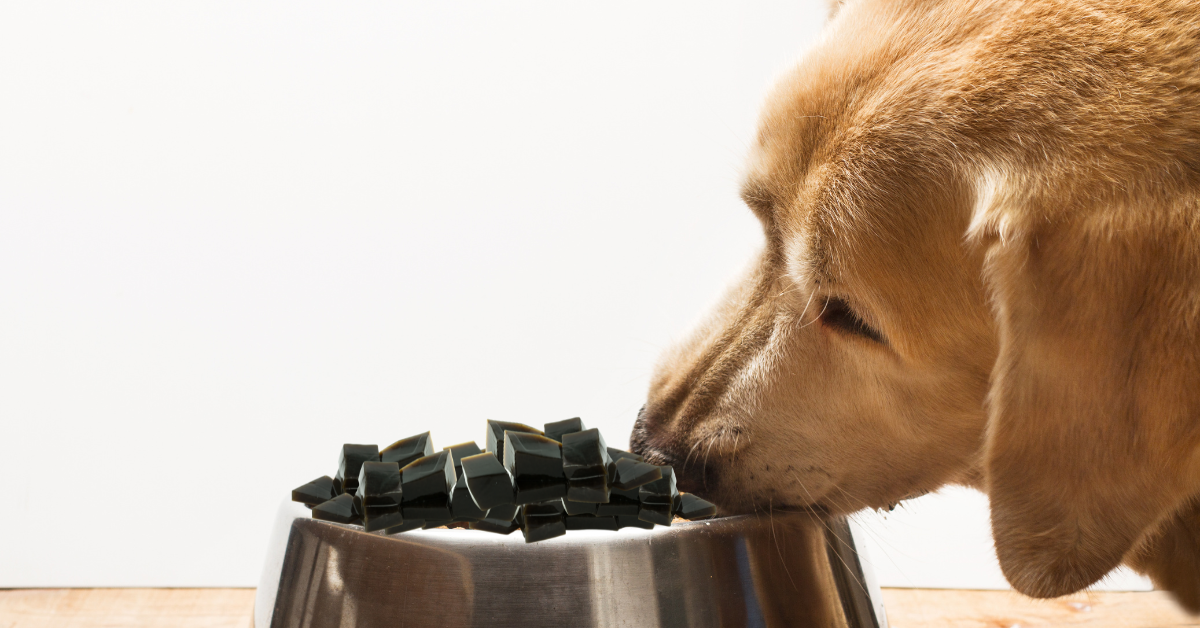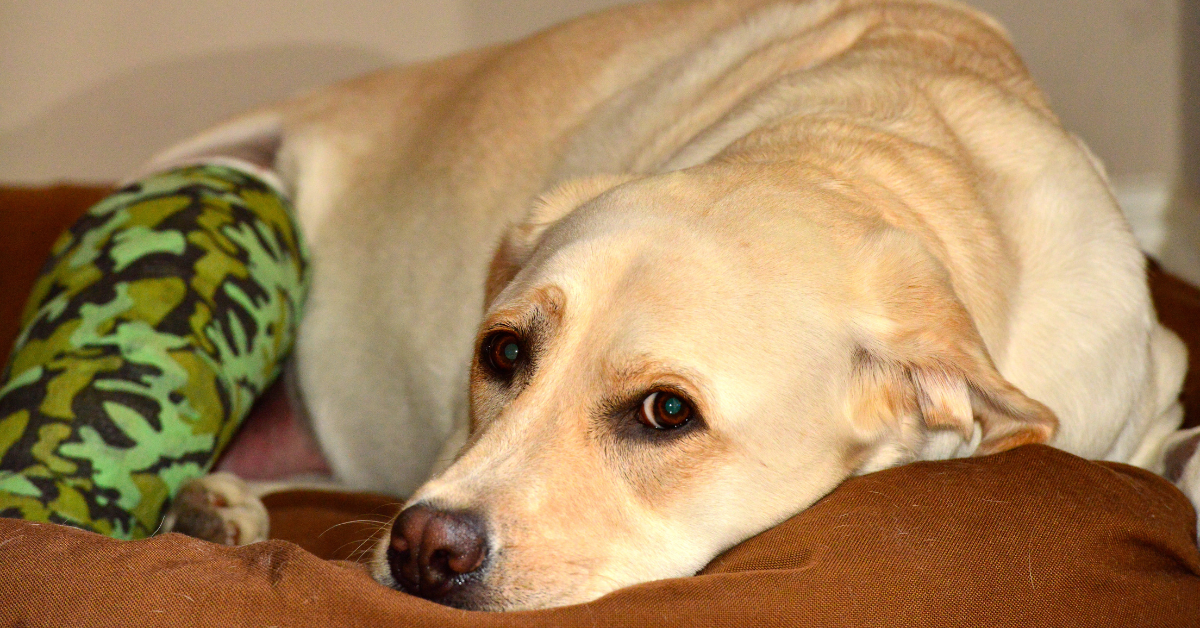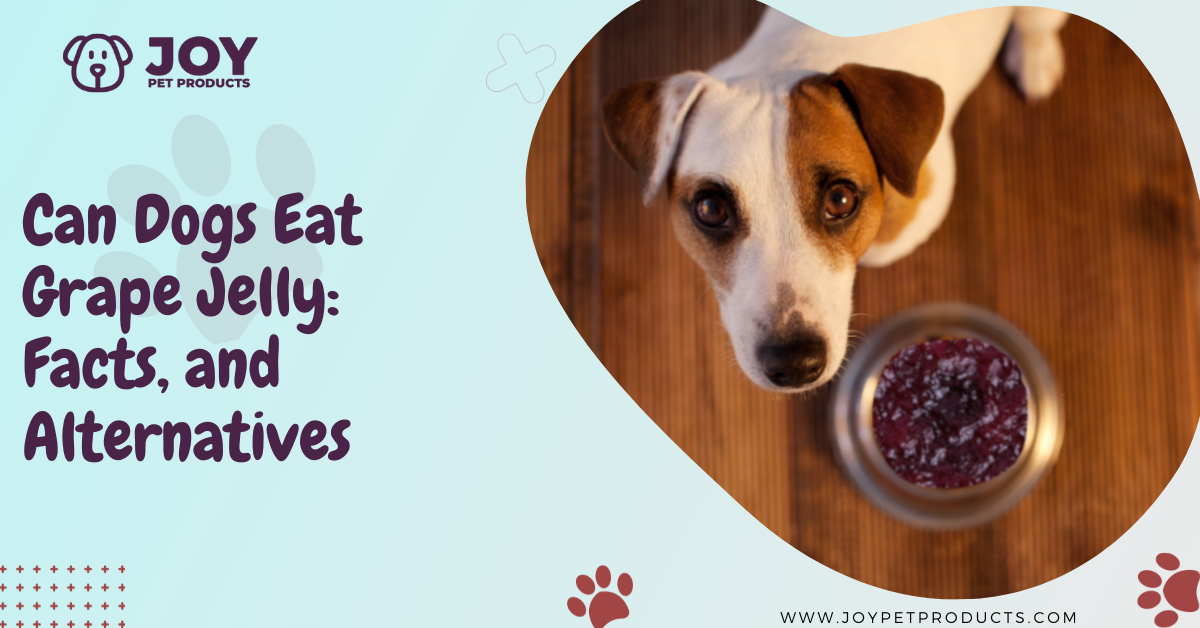Dogs’ curiosity knows no bounds, and their powerful olfactory senses allow them to sniff and comprehend their surroundings. Dogs have the innate ability to smell objects from as far as 12 miles away. It applies to food as well. So, if there’s a tasty delicacy sitting on your plate, your dog won’t take long to get hold of the same.
It is essential to know that all human foods are unsuitable for dogs, and some might have harmful effects. Regarding the list of toxic foods, grapes rank pretty high, whether green or black or seeded or seedless. So what about items made from grapes like jellies, candies, wine, etc.? They are harmful as well.
Let’s read on to know if dogs can eat grape jelly and the dangers they may face from its consumption.
Can Dogs Eat Grape Jelly?

Dogs cannot and should not eat grape jelly, as it is toxic for them. The main reason is that it contains grapes, which are highly toxic to dogs, resulting in potential health hazards. Grapes contain tartaric acid in increased concentrations, which can produce harmful effects in dogs when ingested, even in small amounts.
A spoonful of grape jelly could cause dangerous effects on your dog, mainly if he is small in size or has any underlying medical condition. Besides the toxicity of grapes, another alarming factor is the increased sugar content of grape jelly since they are prepared from fructose corn syrup and corn syrup.
It could trigger obesity, gastrointestinal disorders, and diabetes in dogs when consumed excessively.
How Much Grape Jelly Is Toxic to Dogs?
The amount of grape jelly that may result in toxic effects in dogs is unknown. A lot depends on the dog’s size and overall weight. It has been estimated that around three grapes or raisins may prove fatal for pups weighing 2.5 pounds.
On the other hand, 12-15 grapes or raisins may have life-threatening effects on dogs weighing approximately 10 pounds. So, if you have a Chihuahua, Yorkshire Terrier, or Maltese, don’t give them grapes of this amount as it could be fatal for them.
When it comes to grape jelly, a full teaspoon might be hazardous to small breeds. That doesn’t mean big dogs are free from danger. Irrespective of the size, grapes or any of its products are toxic to dogs and must be avoided.
What Should I Do if My Dog Ate Grape Jelly?

If you mistakenly left the grape jelly bottle on the table and find half of it empty, with most of the jelly smeared around your dog’s mouth – you can well sense what went wrong. When something like this happens, you’ll surely panic.
But in such times of crisis, maintaining calm is of utmost importance. These are a few things to do from your end if your dog ate grape jelly: Let’s take a look at them:
1. Assess the Situation
It’s one of the most important things to do. When your dog has eaten grape jelly, note the amount he ate. Also, quickly examine the jelly bottle and check the ingredient list.
Another important thing to note is whether it was just grape jelly or other additives, like a chocolate chip cookie or bagel smeared with jelly. If that’s the case, then alongside grape toxicity, the vet will also have to address the concern of chocolate poisoning.
The more information you gather, the better for the vet to accurately diagnose your dog’s condition.
2. Monitor Your Dog’s Symptoms

Is your dog fine after having grape jelly? Even if your dog appears alright, you should not assume things are fine. You must monitor him closely for about a day to ensure he’s out of danger.
However, look at the following symptoms, and if you find your dog showing any or many of them, you will have to contact the vet immediately. Here are some of the alarming signs to watch out for:
- Lessened appetite
- Inactivity/lethargy
- Diarrhea
- Vomiting
- Abdominal pain
- Dehydration
3. Contact the Vet
You can call the vet right after your dog has eaten grape jelly for self-assurance. However, if your dog is okay for the time being, you may choose to wait for some more time and see how your dog is throughout the day after consuming the grape jelly. But when you notice discomfort in your dog, do not delay contacting the vet.
Early intervention and immediate treatment can save your dog from serious health hazards. Never try to induce vomiting in dogs at home. You could be harming your dog this way than doing any good. Leave that to your vet. He will do it at his office if he feels the need to induce vomiting.
4. Clear the Mess

It’s another vital point to keep in mind. When you see your dog has eaten grape jelly, you must clear the mess so that he doesn’t eat any more of it. If you find the jelly bottle open, lid it well, and keep it in a place away from your dog’s reach.
If he is licking the leftovers from the plate, take it away from his sight immediately. While you settle things, you can leave your dog in another room and keep him busy with his favorite toy.
What is Grape Poisoning?
Grape poisoning means that when your dog has grapes or any product made of grapes, it could react sensitively in his system, resulting in toxic effects. Dogs are toxic to:
- Seedless or seeded grapes
- Homegrown or commercially manufactured grapes
- Red or green grapes or raisins
- Products made from grapes, currants, and raisins
The extent to which grapes may cause toxic effects in dogs is unknown. It all depends on his size, weight, amount ingested, and tolerance levels. However, one thing stands clear – increased consumption of grapes or edibles made of grapes will lead to more damage.
The tartaric acid content in grapes is the main culprit, which does most of the damage.
The main harm tartaric acid does is attack the dog’s kidneys, lessening their functionality. It may result in kidney failure in the long run.
Initially, it was speculated that the toxicity in grapes was due to mycotoxin and salicylate, possibly producing harmful effects on the dog’s kidney. There is, however, a debate regarding the exact toxin in grapes that results in damage.
Symptoms of Grape Poisoning in Dogs

When your dog eats grape jelly, chances are that he will show symptoms of grape poisoning, which have been elaborated as follows:
- Vomiting (the most common symptom observed within 24 hours of ingestion of grapes)
- Loss of appetite, weakness, and lethargy (seen in 12-24 hours of ingestion)
- Kidney damage (observed in 24-48 hours after eating grapes)
When your dog has acute kidney failure due to grape poisoning, he will show some of these symptoms as given below:
- Nausea
- Vomiting
- Lessened appetite
- Abdominal pain
- Excessive thirst
- Increased urination or no urination at all (when the toxin gets deep into the dog’s system and affects the normal functioning of his kidneys)
- Increased blood pressure
- Mouth ulcers
- Pale gum
- Blood in their urine
- Intestinal seizures
- Uncoordinated movements
- Drastic weight loss
- Tremor
- Coma (when the wastes that the dog’s kidney eliminates build up in his body)
Grape poisoning is a medical emergency and needs immediate medical attention when diagnosed. The slightest delay may be life-threatening for your canine friend.
Treatment of Grape Poisoning in Dogs
The earlier your dog is given medical aid, the quicker the chances of recovery. If it hasn’t been more than two hours since your dog has eaten grapes, the vet may attempt to induce vomiting to lessen further absorption of the toxin into the dog’s system.
However, raisins and grapes remain in your dog’s stomach for quite a long. So, the vet can consider inducing vomiting for up to six hours after the dog has eaten the grapes.
Your vet might also give your dog activated charcoal. It will help bind the toxic elements to the intestine and prevent them from getting absorbed into your dog’s system. However, it would help if you didn’t try to induce vomiting at home. If you do so, you may end up harming your dog rather than helping him out.
In the case of increased ingestion, your dog will have to be put on intravenous fluids for at least two days. It’ll help flush out the toxins from your dog’s body by increasing urine production.
When your dog’s urine production doesn’t improve even after you’ve given him IV fluids, further medications will be needed to enhance kidney function.
Are There Any Alternatives to Grape Jelly?

If you want to give your dog fruits, there are also safer options that could serve as a better alternative. These include apples, strawberries, cantaloupes, and so on, which can be given to your dog in moderation.
You could make several homemade treats for your dogs with these fruits. For instance, apple chips, apple pretzels, etc., would be a bad option. Just keep a check on the sugar content. The same goes for other dig-safe fruits as well.
FAQ’s
How do you prevent your dog from eating grapes or grape products?
The first thing to do is to keep grapes, raisins, currants, and products made from grapes out of the dog’s reach. Put them in a jar and lock them inside a cabinet so your dog cannot access it. Avoid giving your dog treats with grapes, currants, or raisins.
How long does it take for the dog to recover from grape poisoning?
It depends on the severity of the situation. The most harm is caused due to increased consumption and needs immediate treatment. The earlier your vet gets medical assistance, the sooner he will recover.
Can dogs eat jelly?
Jelly isn’t a safe option for dogs to eat, as they have an increased sugar content. Also, some jellies have xylitol, an artificial sweetener that is considered toxic to canines. Xylitol poisoning may lead to hypoglycemia and even prove fatal for dogs.
What if your dog eats peanut butter and grape jelly?
Dogs can eat peanut butter in moderation, sans the artificial sweetener xylitol. But grape jelly is a no-no for your canine. So, drop the idea of combining the two and giving it your canine as a treat.
Conclusion
So, before pampering your dog with a dollop of grape jelly, which he demands from your plate, keep in mind that by showing love this way, you’ll harm him all the more.
Instead, it would be best to choose healthier options prepared with fruits like strawberries, blueberries, watermelons, apples, bananas, etc.
Elena Gherman is a highly skilled and knowledgeable animal care expert. At the start of her career, she gained practical expertise with multiple animals. In addition to that, she works as a DVM veterinary editor for Joy Pet Products, which focuses on offering reliable information on pet health and wellbeing. She meticulously reviews each piece of writing before it is published to make sure pet owners get the most precise and updated information possible.
